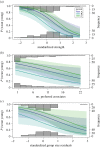Higher sociability leads to lower reproductive success in female kangaroos
- PMID: 32968533
- PMCID: PMC7481692
- DOI: 10.1098/rsos.200950
Higher sociability leads to lower reproductive success in female kangaroos
Abstract
In social mammals, social integration is generally assumed to improve females' reproductive success. Most species demonstrating this relationship exhibit complex forms of social bonds and interactions. However, female eastern grey kangaroos (Macropus giganteus) exhibit differentiated social relationships, yet do not appear to cooperate directly. It is unclear what the fitness consequences of such sociability could be in species that do not exhibit obvious forms of cooperation. Using 4 years of life history, spatial and social data from a wild population of approximately 200 individually recognizable female eastern grey kangaroos, we tested whether higher levels of sociability are associated with greater reproductive success. Contrary to expectations, we found that the size of a female's social network, her numbers of preferential associations with other females and her group sizes all negatively influenced her reproductive success. These factors influenced the survival of dependent young that had left the pouch rather than those that were still in the pouch. We also show that primiparous females (first-time breeders) were less likely to have surviving young. Our findings suggest that social bonds are not always beneficial for reproductive success in group-living species, and that female kangaroos may experience trade-offs between successfully rearing young and maintaining affiliative relationships.
Keywords: animal personality; fitness; parity; reproductive success; social bonds; social networks.
© 2020 The Authors.
Conflict of interest statement
We have no competing interests.
Figures


References
-
- Alexander RD. 1974. The evolution of social behavior. Annu. Rev. Ecol. Syst. 5, 325–383. ( 10.1146/annurev.es.05.110174.001545) - DOI
-
- Krause J, Ruxton GD. 2002. Living in groups. Oxford, UK: Oxford University Press.
-
- Menz CS, Goldizen AW, Blomberg SP, Freeman NJ, Best EC. 2017. Understanding repeatability and plasticity in multiple dimensions of the sociability of wild female kangaroos. Anim. Behav. 126, 3–16. ( 10.1016/j.anbehav.2017.01.012) - DOI
Associated data
LinkOut - more resources
Full Text Sources
Other Literature Sources
